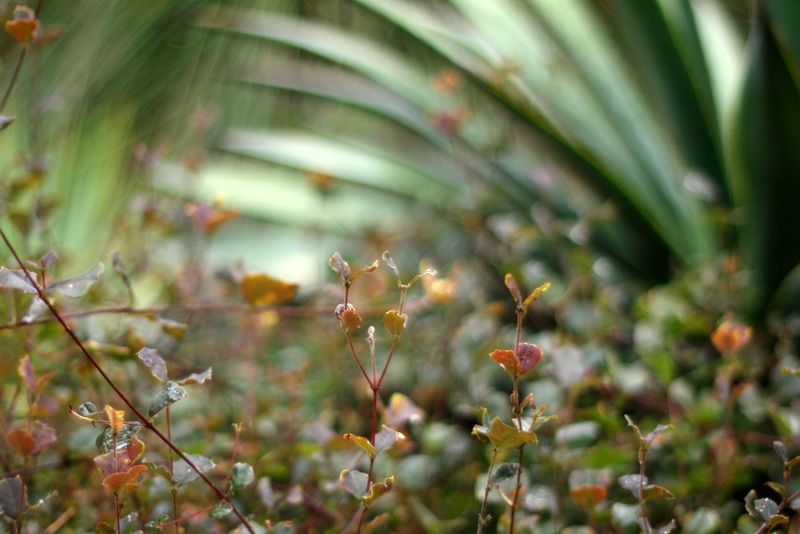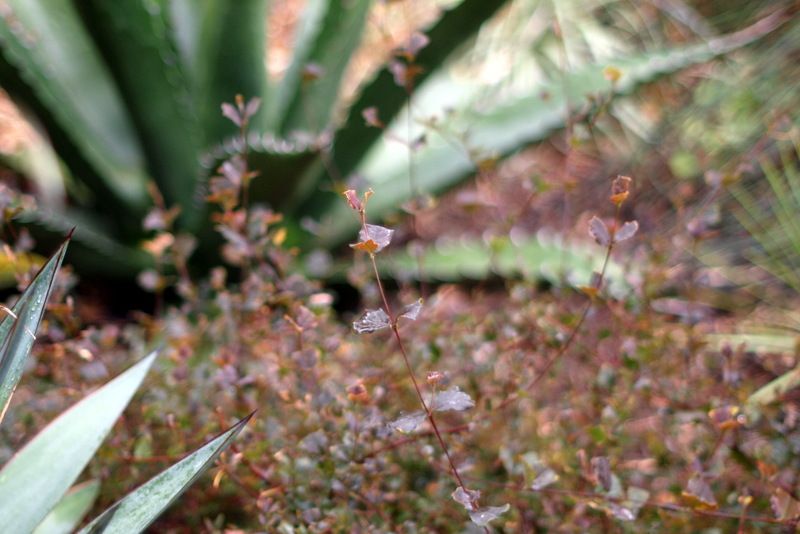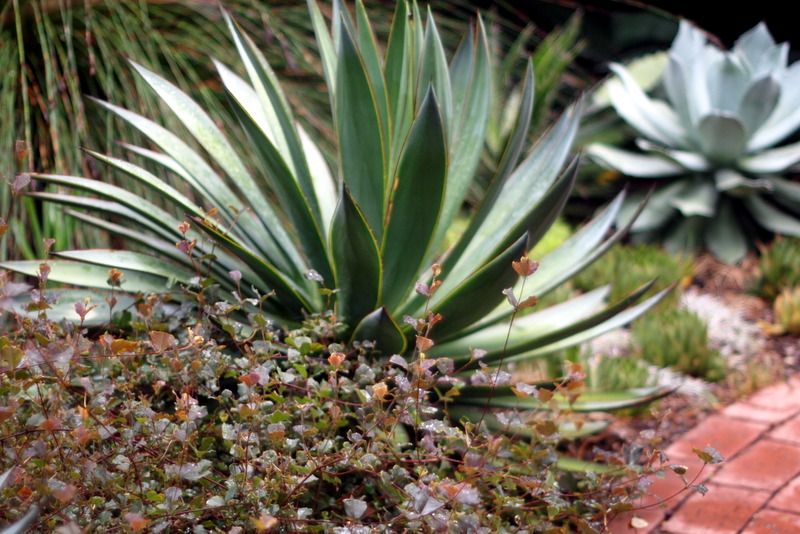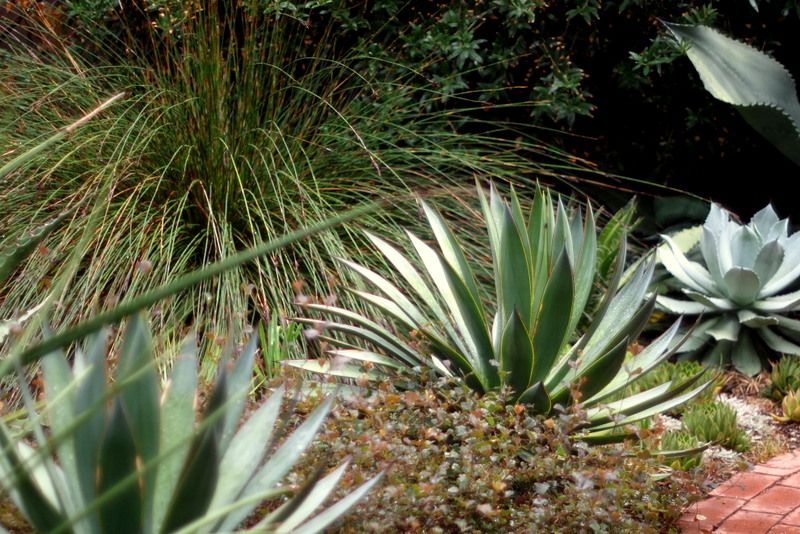
Before September turns the corner into fall, when my garden plans will predictably revive and become hopeful and catalogue-driven once again, it’s a good opportunity to take a clear-eyed look at the survivors. The survivors are once-treasured plants that slowly over time become mere backdrop to the latest and newest treasures. The garden changes so often that there are few plants that date back even a decade. This plant is the rare exception, having been a survivor for donkey years, (old slang for a very long time), going back to when it was purchased sometime in the ’90s. After purchase I promptly forgot its name, only remembering ‘Bronze Butterfly,’ because it just so happened that for once the name was a true and vivid description of the plant.

Old photo showing the bright edge to the leaf margins in spring, with the leaves appearing much darker, almost black.
When the Internet became available (an event that divides my life pre and post more than anything else, with the exception of possibly marriage and kids), a Google search confirmed it as Brachysema praemorsum from Australia. Not only time and technology but taxonomy marches on as well, and currently brachysema is known as gastrolobium. What hasn’t changed is its consistently gorgeous appearance for over a decade now in the front gravel garden. In fact, it’s probably the oldest plant in the garden.* I pulled it from the California native section of a long-defunct nursery near Palos Verdes, Calif, that according to this article closed in 1997 due to the economic effects of severe drought followed by recession in that decade. So I must have brought it home sometime before ’97, at least. I’ve never seen the plant for sale again.

It might not ever make Plant of the Year, but it has many admirable qualities. First and foremost is its ability to live among agaves and dasylirions on their irrigation schedule, which is pretty much when it rains, and you know how well that’s been going lately. It is from Australia, that continent with so many sympatico, mediterranean-adaptive plants for use in our Southern Calif. gardens. A light clipping to keep it off the agaves is probably the only attention it receives. It doesn’t build up a lot of dead growth in the interior and always looks fresh. When in bloom, the claw-like, red flowers don’t read especially well amongst the leaves and for me aren’t the main attraction.

It’s really all about the wiry quality to the stems, upon which float the opposite, winged, richly colored leaves. Its meandering tracery makes a fine counterpoint among the solidity of agaves.
Along with durability, a big reason for its survival in the garden is that it never becomes an exasperating or annoying presence. It just never has a bad day. (On the strength of BB’s performance, another gastrolobium was added this year, G. sericeum, from Australian Native Plants Nursery near Ojai.)

I have a strong suspicion the two ‘Blue Glow’ agaves that bookend the gastrolobium will complete their life cycle and bloom next year, another reason to do a little portrait of this part of the garden now.

Another old-timer is the restio behind the agaves. (It’s hard, for me anyway, to tell restios apart, but I think this is Thamnochortus insignis, about 3 feet tall after many years and sprawling to maybe 5 feet in diameter.) With ‘Bronze Butterfly,’ these two are the oldest plants in the front gravel garden, which was lawn in the pre-Internet days when we bought the house. Back then I took out the lawn because I was greedy for space to grow plants. I was actually worried for a time that neighbors would complain of our lawnless state. Now that having a green lawn has become a cause for complaint, I’m hopeful that, unlike the Palos Verdes Begonia Farm, nurseries won’t close due to drought but will instead thrive as robust gardens replace lawn as the new normal. There’s so many great plants out there just waiting to prove what beautiful survivors they can be.
*San Marcos Growers describes it as a 2002 Koala Blooms introduction, which would be after the nursery where I purchased it closed in 1997. I can’t account for the discrepancy in dates and have always believed it was purchased at the Palos Verdes Begonia Farm. In any case, it’s been in the garden at least ten years. UCSC lists it as “Brachysema praemorsa.”

Sweet little leaves and you’re absolutely right, it’s perfect with agaves! It’s always sad when an independent nursery closes which has happened all too often in the last 20 or so years.
It looks fabulous with its dainty leaves and airy look to it, understated beauty. Glad to hear that water wise yet beautiful plants are becoming the norm there and growing in popularity and acceptance.
@Peter, I guess it’s freaking me out to see so much dead lawn instead of new garden.
@M&G, the commercial landscaping projects around town have really embraced the new norm. Lots of good ideas there.
I still miss Begonia Farms. I used to haunt the place every single weekend, although at the time I had only the tiniest of gardens backing a 2-on-a-lot townhouse. I was so devastated when it closed that my husband (who has no interest in gardening whatsoever) researched nursery alternatives in the area and provided me with a lis. I can’t say I feel the connection with any of them that I felt to Begonia Farms (or Merrihew’s in Santa Monica, which closed years before BF). Your Gastrolobium is a nice groundcover and it sounds as though it’s more drought tolerant than San Marcos Growers gave the plant credit for being.
Kris, so you were prowling nurseries back then too. My boys played in that little gazebo with the giant plastic waffle blocks while I shopped. Yes, it seems to be amazingly drought tolerant. Nice to find GCs that don’t upstage but work with agaves, and this is one.
Neat looking plant, I’d like to try that one.
Your ‘Blue Glow’s still look pretty juvenile to me.
I know this bracysema from around 2003, when we first did the SF Garden Show. At that time it was a new introduction from UC Santa Cruz ‘Koala Blooms’ series and Suncrest and I think San Marcos were growing it. I managed to kill it somehow at my house, but I think M True still has it in a container. Don’t know if anyone is still growing it, loved seeing it at your place recently & love the photos here. You’re right, it’s a tough customer & looks good.
This plant, G. praemorsum, is a variety of the plants that grow naturally along the road sides in Kendenup, South Western Australia. You can find them in bright green through to a deep burgundy colour, each colour on distinct plants. Be a touch careful … It’s cousin G. bilobum, not a look alike, contains the deadly monofluoroacetic acid and as a consequence it is extremely toxic, many non-native animals have died from ingesting it. Such is that poison that they make it commercially (the sodium salt of the acid is known as 1080 poison ). Hence the name associated to the genus Gastrolobium ‘The Poison Peas’.
Fascinating info, Andre, thanks. I have even more respect for this plant now!